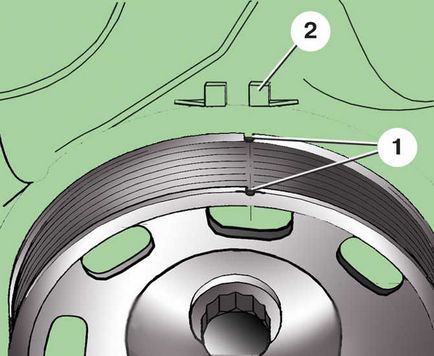 Setting the piston 1. cylinder at TDC
Setting the piston 1. cylinder at TDC
Blowing work on the engine and ignition requires setting the pistons to TDC (top dead center). In four-stroke engines, the piston reaches twice its TDC during one work cycle. The first time when igniting the sucked-in portion of the mixture, and the second time when removing the exhaust gases. In general, the piston is adjusted during various adjustment work 1. cylinder in ignition position.
Four-cylinder gasoline engine. Piston in 1. cylinder (also in 4.) will be in a dead position, when the TDC mark on the camshaft sprocket coincides with the mark on the cylinder head cover.
Six-cylinder gasoline engine. Align the markings on the lower pulley and the toothed belt cover. At the same time, the large holes in the retaining plates on both camshaft sprockets should be facing the center of the engine.
Diesel engine. There is a GMP marking on the flywheel. It must be visible through the opening in the clutch housing.
Next steps:
1. Apply the emergency brake and put the gearshift lever in neutral.
2. Remove the toothed belt cover (there are two covers on the six-cylinder engine). It is not necessary to remove the cover on a diesel engine.
3. Use the ratchet wrench to turn the crankshaft pulley in the direction of its rotation while the engine is running, until the markings described above overlap. The toothed belt is heavily loaded during this operation, under no circumstances turn the timing pinion of the toothed cat. Access to the bolt on the crankshaft pulley is very difficult and the need to remove the shock absorber is not excluded. You can also turn the crank watt, engaging fourth gear and rolling the car, then the crank wattage also rotates. Another option is to apply the emergency brake, lifting and supporting the car, engaging fifth gear and turning the front cat by hand. Both of the latter methods, the second person must observe the GMP marking.
